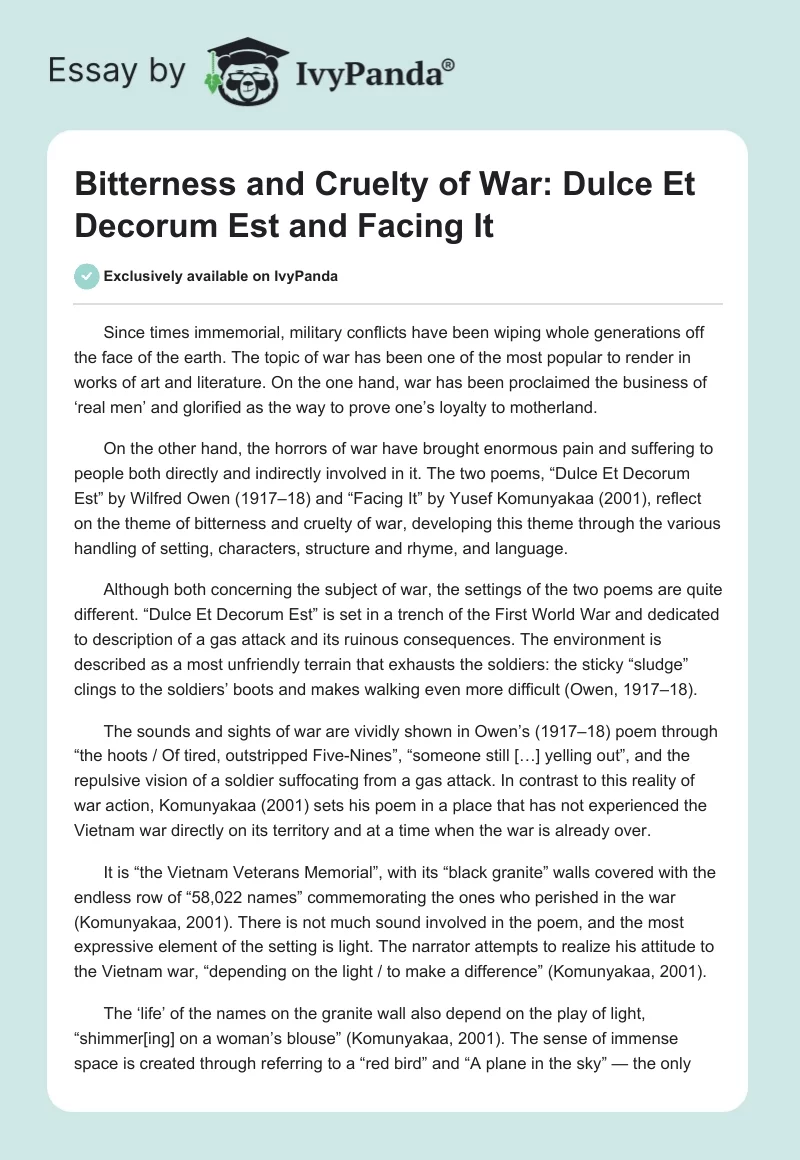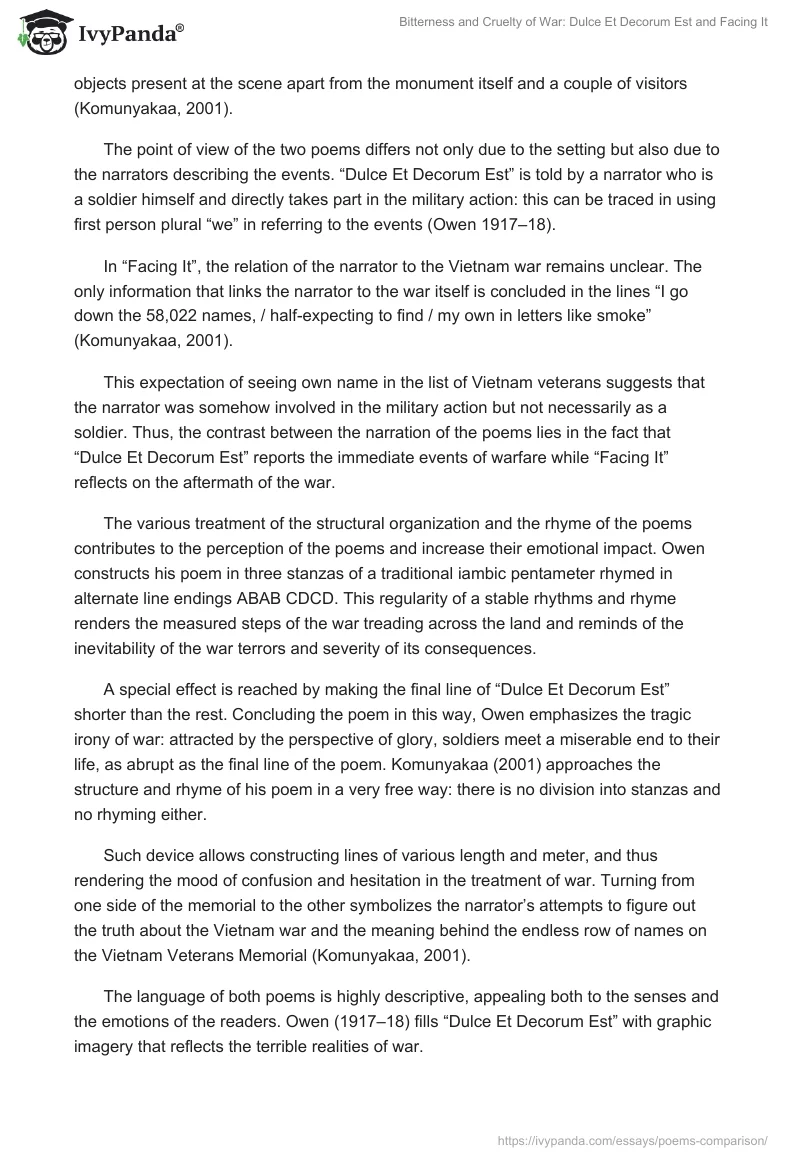Since times immemorial, military conflicts have been wiping whole generations off the face of the earth. The topic of war has been one of the most popular to render in works of art and literature. On the one hand, war has been proclaimed the business of ‘real men’ and glorified as the way to prove one’s loyalty to motherland.
On the other hand, the horrors of war have brought enormous pain and suffering to people both directly and indirectly involved in it. The two poems, “Dulce Et Decorum Est” by Wilfred Owen (1917–18) and “Facing It” by Yusef Komunyakaa (2001), reflect on the theme of bitterness and cruelty of war, developing this theme through the various handling of setting, characters, structure and rhyme, and language.
Although both concerning the subject of war, the settings of the two poems are quite different. “Dulce Et Decorum Est” is set in a trench of the First World War and dedicated to description of a gas attack and its ruinous consequences. The environment is described as a most unfriendly terrain that exhausts the soldiers: the sticky “sludge” clings to the soldiers’ boots and makes walking even more difficult (Owen, 1917–18).
The sounds and sights of war are vividly shown in Owen’s (1917–18) poem through “the hoots / Of tired, outstripped Five-Nines”, “someone still […] yelling out”, and the repulsive vision of a soldier suffocating from a gas attack. In contrast to this reality of war action, Komunyakaa (2001) sets his poem in a place that has not experienced the Vietnam war directly on its territory and at a time when the war is already over.
It is “the Vietnam Veterans Memorial”, with its “black granite” walls covered with the endless row of “58,022 names” commemorating the ones who perished in the war (Komunyakaa, 2001). There is not much sound involved in the poem, and the most expressive element of the setting is light. The narrator attempts to realize his attitude to the Vietnam war, “depending on the light / to make a difference” (Komunyakaa, 2001).
The ‘life’ of the names on the granite wall also depend on the play of light, “shimmer[ing] on a woman’s blouse” (Komunyakaa, 2001). The sense of immense space is created through referring to a “red bird” and “A plane in the sky” — the only objects present at the scene apart from the monument itself and a couple of visitors (Komunyakaa, 2001).
The point of view of the two poems differs not only due to the setting but also due to the narrators describing the events. “Dulce Et Decorum Est” is told by a narrator who is a soldier himself and directly takes part in the military action: this can be traced in using first person plural “we” in referring to the events (Owen 1917–18).
In “Facing It”, the relation of the narrator to the Vietnam war remains unclear. The only information that links the narrator to the war itself is concluded in the lines “I go down the 58,022 names, / half-expecting to find / my own in letters like smoke” (Komunyakaa, 2001).
This expectation of seeing own name in the list of Vietnam veterans suggests that the narrator was somehow involved in the military action but not necessarily as a soldier. Thus, the contrast between the narration of the poems lies in the fact that “Dulce Et Decorum Est” reports the immediate events of warfare while “Facing It” reflects on the aftermath of the war.
The various treatment of the structural organization and the rhyme of the poems contributes to the perception of the poems and increase their emotional impact. Owen constructs his poem in three stanzas of a traditional iambic pentameter rhymed in alternate line endings ABAB CDCD. This regularity of a stable rhythms and rhyme renders the measured steps of the war treading across the land and reminds of the inevitability of the war terrors and severity of its consequences.
A special effect is reached by making the final line of “Dulce Et Decorum Est” shorter than the rest. Concluding the poem in this way, Owen emphasizes the tragic irony of war: attracted by the perspective of glory, soldiers meet a miserable end to their life, as abrupt as the final line of the poem. Komunyakaa (2001) approaches the structure and rhyme of his poem in a very free way: there is no division into stanzas and no rhyming either.
Such device allows constructing lines of various length and meter, and thus rendering the mood of confusion and hesitation in the treatment of war. Turning from one side of the memorial to the other symbolizes the narrator’s attempts to figure out the truth about the Vietnam war and the meaning behind the endless row of names on the Vietnam Veterans Memorial (Komunyakaa, 2001).
The language of both poems is highly descriptive, appealing both to the senses and the emotions of the readers. Owen (1917–18) fills “Dulce Et Decorum Est” with graphic imagery that reflects the terrible realities of war.
The myth about the brave and fine soldiers is shattered by their description as “Bent double, like old beggars under sacks, / Knock-kneed, coughing like hags” (Owen, 1917–18). Not the desire to fight but “fatigue” is the only feeling that drives the “lame”, “blind”, and “deaf” soldiers to go on (Owen, 1917–18).
Not the neat ranks but confused, “stumbling” and “fumbling” tired men struggle to put on their “clumsy helmets” when gas alert comes (Owen, 1917–18). These disturbing images are further intensified by the naturalistic description of a soldier affected by gas, a vision far from the romanticized ideal of war.
In “Facing It”, Komunyakaa (2001) employs sharp contrasts and the play of light to emphasize the emotional instability the narrator experiences facing the war memorial. The most painful opposition is represented in the line “I’m stone. I’m flesh.”, which suggests that the narrator is taken as a kind of a war monument by the society but in fact he is a living being with his tragedy and pain (Komunyakaa, 2001).
The vagueness of his situation is prompted throughout the poem by such words as “clouded reflection”, “my own [name] in letters like smoke”, “then his pale eyes / look through mine. I’m a window.” (Komunyakaa, 2001). It appears that the narrator has lost his individuality in course of the war and now is merely a reflection of the pain and the terror experienced by millions during the military actions.
Upon the analysis of the poems, it appears that through the setting, characters, structure and rhyme, and language, both Owen (1917–18) and Komunyakaa (2001) succeed in reflecting the major theme of the tragedy and pain war brings to people.
The difference between the two poems is that “Dulce Et Decorum Est” shows the war reality through reporting the direct events of a military operation and appealing to the senses of the readers. On the other hand, “Facing It” represents a reflective intellectual poem, contemplating on the fates of the millions affected by war both directly and indirectly.
References
Komunyakaa, Y. (2001). Facing it. Retrieved from https://www.poetryfoundation.org/poems/47867/facing-it
Owen, W. (1917–18). Dulce et decorum est. Web.


